Sardinien-Piemont |
|
|
|
| Übersicht – Contents: | |
Sardinien-Piemont |
|
|
|
| Übersicht – Contents: | |
Flagge – Flag: |
|
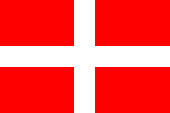 |
1720–1802, Flagge Sardinien-Piemont – flag of Sardinia-Piedmont, Quelle/Source: nach/by: Wikipedia (EN) |
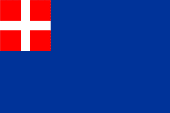 |
1720–1802, Marineflagge Sardinien-Piemont – naval flag of Sardinia-Piedmont, Quelle/Source: nach/by: Wikipedia (EN) |
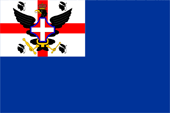 |
1802–1814, Marineflagge Sardinien-Piemont – naval flag of Sardinia-Piedmont, Quelle/Source: nach/by: Flags of the World |
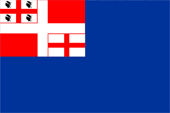 |
1814–1816, Marineflagge Sardinien-Piemont – naval flag of Sardinia-Piedmont, Quelle/Source: nach/by: Flags of the World |
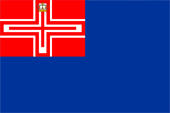 |
1816-1848, Staatsflagge Sardinien-Piemont – state flag of Sardinia-Piedmont, Quelle/Source: Wikipedia (EN) |
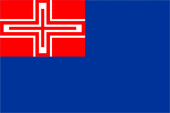 |
1816-1848, Marineflagge Sardinien-Piemont – naval flag of Sardinia-Piedmont, Quelle/Source: Wikipedia (EN) |
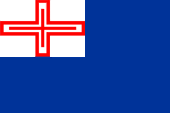 |
1816-1848, Handelsflagge Sardinien-Piemont – merchant flag of Sardinia-Piedmont, |
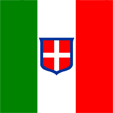 |
1848-1851, Staatsflagge Sardinien-Piemont – state flag of Sardinia-Piedmont, Quelle/Source: Wikipedia (EN) |
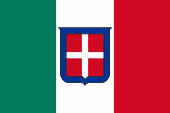 |
1851-1861, National- und Handelsflagge Sardinien-Piemont – national and merchant flag of Sardinia-Piedmont, Quelle/Source: Wikipedia (EN) |
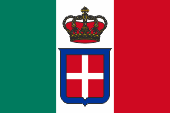 |
1851-1861, Staats- und Marineflagge Sardinien-Piemont – state and naval flag of Sardinia-Piedmont, Quelle/Source: Wikipedia (EN) |
|
|
|
Bedeutung/Ursprung der Flagge – Meaning/Origin of the Flag: |
|
| Nach der Vereinigung von Savoyen-Piemont mit dem Königreich Sardinien im Jahre 1720 wurde zunächst die Flagge von Savoyen-Piemont beibehalten. Sie zeigte ein weißes Balkenkreuz auf Rot, die Heraldik des Hauses Savoyen. | After the
unification of Savoy-Piedmont with the Kingdom of Sardinia in 1720, the flag
of Savoy-Piedmont was maintained initially. It showed a white cross on a red background, the heraldry of the House of Savoy. |
| Nachdem Napoléon Savoyen-Piemont besetzt und annektiert hatte, beschränkte sich das Herrschaftsgebiet des Haues Savoyen auf die Insel Sardinien. Das weiße Balkenkreuz erschien ab 1802 auf den Flaggen nur noch auf dem Brustschild eines Adlers, der auf eine Obercke platziert war, welche die Heraldik des Königreiches Sardinien zeigte, ein rotes Balkenkreuz auf Weiß, und in den weißen Flächen erschienen vier Mohrenköpfe. | After
Napoléon had occupied and annexed Savoy-Piedmont, the by the House of Savoy
ruled territory was confined to the island of Sardinia. The white bars cross appeared on the flags from 1802 only on a breastplate of an eagle, which was placed on a upper corner, which showed the heraldry of the Kingdom of Sardinia, a red bars cross on white, and in the white fields appeared four Heads of Moors. |
| Zwischen 1814 und 1816 erschien noch mal eine Flagge, welche die Heraldik des Hauses Savoyen mit der des Königreichs Sardinien zu kombinieren versuchte. | Between 1814 and 1816 appeared a flag again, which tried to combine the heraldry of the House of Savoy with the heraldry of the Kingdom of Sardinia. |
| Ab 1816, das Staatsgebiet war wieder hergestellt, erschienen neue Flaggen, auf denen die Kombination der Heraldik des Hauses Savoyen mit der des Königreichs Sardinien gut gelungen ist. Rote und weiße Kreuze wurden in- und aufeinandergelegt. | From 1816 - the territory of the state was meanwhile restored - new flags appeared, on which the combination of the heraldry of the House of Savoy, with those of the Kingdom of Sardinia, was well done. Red and white crosses were placed in and on each other. |
| Von 1848 bis 1849 wütete in fast ganz Italien der Aufstand der Volksbewegung "Giòvane Itàlia" unter Mazzini und Garibaldi, die Monarchien waren oft kurz entmachtet. Karl Albert von Sardinien-Piemont stellt sich an die Spitze der Erhebung, jedoch endet die nationale italienische Erhebung in Uneinigkeit. In dieser Aufstandsphase wurden in den italienischen Staaten auch national-italienische Flaggen in Grün, Weiß und Rot verwendet. | From 1848 to 1849 raged in almost all of Italy the uprising of the people's movement "Giòvane Itàlia" under Mazzini and Garibaldi, the monarchies were often shortly disempowered, Charles Albert of Sardinia-Piedmont sets himself at the top of the uprising, but the Italian uprising ends in disagreement. In this phase of rebellion in the Italian States were often used national-italian flags in green, white and red. |
| Schon im März 1848 hatte Sardinien-Piemont eine grün-weiß-rote Flagge angenommen, um den italienischen Charakter seines Staatsvolkes hervorzuheben und um den nationalen Gedanken populär zu machen. Zur Unterscheidung trug die Flagge in der Mitte das Wappen das Hauses Savoyen. Dies Flagge wurde bis zur Krönung von Viktor Emanuel II. von Sardinien-Piemont zum König des Königreichs Italien beibehalten und dann als National- und Handelsflagge bzw. Staats- und Marineflagge für Italien übernommen. | Already
in the March 1848 Sardinia-Piedmont had adopted a green-white-red flag, to
highlight the Italian character of its citizenry, and for popularizing to
the national idea. To distinguish the flag from others, the coat of arms of
the House of Savoy was placed in the middle. This flag was maintained until the coronation of Victor Emmanuel II. of Sardinia-Piedmont to the King of the Kingdom of Italy and then it was taken over as national and merchant resp. state and naval flag for Italy. |
| Quelle/Source: World Statesmen, Flags of the World, Wikipedia (EN) | |
| Historische Staaten in Italien – Historical states in
Italy: ca. 1850–1858 alle Staatsbezeichnungen in Englisch – all state denominations in English |
|
| Landkarte/Map: Volker Preuß |
Zahlen und Fakten – Numbers and Facts: |
|
|
|
|
|
|
|
|
|
|
|
Geschichte: |
|
1701–1713
· Spanischer Erbfolgekrieg 1714 · Friedensvertrag von Utrecht, das Haus Savoyen erwirbt das Königreich Sizilien 1718 · im Tausch gegen Sizilien kommt das Königreich Sardinien an das Haus Savoyen 1720 · Vereinigung von Savoyen-Piemont mit dem Königreich Sardinien, der Titel König von Sardinien kommt so an den Herzog von Savoyen, Errichtung des Königreichs Sardinien-Piemont durch das Haus Savoyen 1796 · nach der Eroberung durch französische Truppen wird in Piemont die Republik Alba (von Napolèons Gnaden) ausgerufen 1798 · Proklamation der Piemontesischen Republik (von Napolèons Gnaden) 1800 · Umbenennung der Piemontesischen Republik in Subalpine Republik (von Napolèons Gnaden) 1802 · direkte Annexion ganz Piemonts durch Frankreich, der Staat Sardinien-Piemont besteht auf der Insel Sardinien als Rumpfstaat weiter 1814/15 · Wiener Kongress, Neuordnung Europas nach der Ära Napoléon, Wiederherstellung des Königreichs Sardinien-Piemont, die Republik Genua wird Sardinien-Piemont angeschlossen 1821 · revolutionäre Unruhen, Österreich greift ein 1847 · anti-österreichische Aufstände 1848 · in fast ganz Italien Aufstand der Volksbewegung "Giòvane Itàlia" unter Mazzini und Garibaldi, Karl Albert von Sardinien-Piemont stellt sich an die Spitze der Erhebung, die italienische Erhebung endet in Uneinigkeit 1859 · italienischer Unabhängigkeitskrieg gegen Österreich, die Lombardei wird von Sardinien-Piemont annektiert 1860 · Guastalla, Parma, Modena, Toskana, Umbrien, Marken und die Romagna werden von Sardinien-Piemont annektiert, Savoyen und Nizza werden an Frankreich abgetreten, Savoyen wird in die Départements Haute-Savoie und Savoie aufgeteilt 17.03.1861 · Krönung von Viktor Emanuel II. von Sardinien-Piemont zum König des Königreichs Italien 1946 · Gründung der Region Piemont als Verwaltungseinheit 1948 · Gründung der Region Sardinien als Verwaltungseinheit |
History: |
|
1701–1713
· Spanish War of Succession 1714 · Peace Treaty of Utrecht, the House of Savoy acquires the Kingdom of Sicily 1718 · in exchange for the Kingdom of Sardinia, Sicily comes to the House of Savoy 1720 · unification of Savoy-Piedmont with the Kingdom of Sardinia, the title of King of Sardinia comes in this way to the Duke of Savoy, establish of the Kingdom of Sardinia-Piedmont by the House of Savoy 1796 · after the conquest by French troops in Piedmont gets proclaimed the Republic of Alba (at Napolèons grace) 1798 · proclamation of the Piedmontese Republic (at Napolèons grace) 1800 · rename of the Piedmontese Republic in Subalpine Republic (at Napolèons grace) 1802 · direct annexation of the whole Piedmont by France, the state of Sardinia-Piedmont exists further as a rump state on the island of Sardinia 1814/15 · Congress of Vienna, reorganization of Europe after the Napoleonic era, restoration of the Kingdom of Sardinia-Piedmont, the Republic of Genoa gets annexed by Sardinia-Piedmont 1821 · revolutionar riots, Austria intervenes 1847 · anti Austrian riotings 1848 · in almost all of Italy uprising of the people's movement "Giovine Italia" under Mazzini and Garibaldi, Charles Albert of Sardinia-Piedmont sets himself at the top of the uprising, the Italian uprising ends in disagreement 1859 · Italian War of Independence against Austria, the Lombardy gets annexed by Sardinia-Piedmont 1860 · Guastalla, Parma, Modena, Tuscany, Umbria, Marches and the Romagna become annexed by Sardinia-Piedmont, Savoy and Nice were to cede to France, Savoy gets divided into the départements of Haute-Savoie and Savoie 17th of March 1861 · coronation of Victor Emmanuel II. of Sardinia-Piedmont to the King of the Kingdom of Italy 1946 · establish of the Piedmont region as an administration unit 1948 · establish of the Sardinia region as an administrative unit |
| Quelle/Source: Wikipedia (D), Atlas zur Geschichte, World Statesmen |
Ursprung des Landesnamens – Origin of the Country's Name: |
|
| Der Name "Sardinien-Piemont" ist nicht ganz unumstritten. Er erklärt die Kombination des Landes aus den beiden Landesteilen Sardinien und Piemont. Das Königreich wurde jedoch häufig nur "Königreich Sardinien" genannt. | The name "Sardinia-Piedmont" is not entirely uncontroversial. It explains the combination of the country by the two parts Sardinia and Piedmont. The kingdom, however, was simply and frequently called "Kingdom of Sardinia". |
| Der Name "Sardinien" geht auf die Sarden zurück, ein Mischvolk, dessen Nachfahren noch heute auf der Insel leben. Die Sarden entstanden durch die Vermischung der Ligurischen Urbevölkerung mit Griechen, Römern, Arabern und Spaniern. | The name
"Sardinia" goes back to the Sardinians, a mixed people, whose descendants
still live on the island. The Sardinians arised by mixing of the original Ligurian population with Greeks, Romans, Arabs and Spaniards. |
| Der Name "Piemont" heißt übersetzt "Fuß des Gebirges", und beschreibt die geographische Lage des Landes. Der italienische Name lautet "Piemonte", der französische "Piedmont". | The name "Piedmont" means "foot of the mountain," and describes the geographical location of the country. The Italian name is "Piemonte", the French "Piedmont". |
| Quelle/Source: Handbuch der geographischen Namen, Volker Preuß | |
| heutige Regionen Italiens – today's regions of Italy: alle Bezeichnungen in Italienisch – all denominations in Italian |
|
| Landkarte/Map: Volker Preuß |